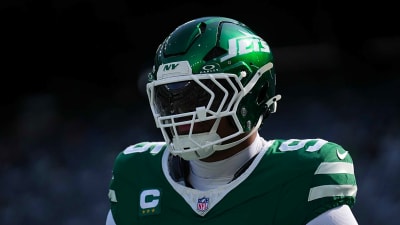
Red-zone opportunity share remains one of the most predictive usage signals in fantasy football. Narrowing the lens to Weeks 7 through 9, several roles moved in ways consensus ranks have not fully priced.
This analysis looks only at plays inside the twenty. For running backs, “share of carries” is the percentage of a team’s red-zone rushes. In the case of receivers and tight ends, “share of targets” is the percentage of a team’s red-zone targets. For multipath backs, “share of opportunities” combines those paths. Red-zone roles are sticky and tend to lead to touchdowns.
Red Zone Share Fantasy Football Impact: Weeks 7-9
Jaxson Dart, New York Giants — Designed Runs Are the Offense in Close
Dart accounts for 70% of New York’s red-zone carries in this span, worth 41% of the Giants’ total red-zone opportunities. That is elite, quarterback-driven finishing. The practical read: New York is comfortable letting Dart end drives on the ground, which caps touchdown ceilings for backs and creates a stable weekly red-zone floor at quarterback. Treat this as a sustainable schematic choice rather than a blip.
Darnell Washington, Pittsburgh Steelers — A Free TE with Real TD Access
Washington logged six red-zone targets across Weeks 7 through 9, 30% of Pittsburgh’s total. The Steelers were the third-most pass-heavy red-zone offense in the league during this window, and 14 of 20 red-zone targets went to tight ends. That is not noise; it reads like a plan. Despite that, Washington still sits outside the top-50 rest-of-season among tight ends. In 12-team formats, that profile should not be on waivers. It is a priority add with weekly touchdown paths baked in.
Xavier Legette, Carolina Panthers — First Read Where it Counts
Legette drew 33% of Carolina’s red-zone targets and operated as the first receiving option inside the twenty. For a second-year wide receiver, that concentration matters more than raw volume. It signals design and trust. In standard leagues, this is WR3/FLEX utility during bye weeks; in deeper formats, it is weekly startable when the Carolina Panthers project multiple red-zone trips.
Jaylen Waddle, Miami Dolphins — Usage Mismatch to Current Rank
Even with Tyreek Hill sidelined, Waddle captured just 7% of Miami Dolphins red-zone opportunities over these three weeks. That is too low for a player currently graded as a low-end WR1 on weekly expert ranks. The conclusion is not a panic sell; it is a reminder to set expectations around volume and yards rather than bankable finishing until the usage inside the twenty rebounds.
George Pickens, Dallas Cowboys — Similar Warning Label
Pickens accounted for only 7% of the Dallas Cowboys’ red-zone opportunities in this window while still being treated as a low-end WR1 in weekly ranks. The talent is obvious, but the recent money-zone role says boom-bust more than automatic. Managers in shallow leagues should be willing to rotate in steadier red-zone roles on a matchup basis.
Brian Thomas Jr., Jacksonville Jaguars — No Red-Zone Targets in Three Weeks
Thomas did not register a single red-zone target across Weeks 7 through 9. His rest-of-season rank has already cooled, but this is a further yellow flag for touchdown expectations. Until Jacksonville shows designs for him inside the twenty, he profiles as a yardage-driven WR3/FLEX.
Chicago Bears and Jacksonville Jaguars — Run-Heavy Red-Zone Identities
Both the Chicago Bears and the Jacksonville Jaguars funneled more than 70% of their red-zone opportunities to the run during this window. Chicago, in particular, recorded more than double the league-average red-zone carries. That tilt elevates D’Andre Swift or Kyle Monangai — whichever back starts for Chicago — into strong touchdown profiles right now. In Jacksonville, Travis Etienne Jr. benefits directly from the team-level commitment to rushing finishes.
Actionable Calls for Week 10 Planning
-
Add/Start in Deeper Leagues: Darnell Washington and Xavier Legette in deeper or bye-week situations.
-
Start/Trade for: Jaxson Dart (rushing TD equity stabilizes QB floor).
-
Reframe: Jaylen Waddle and George Pickens as matchup-driven WR2/FLEX until red-zone roles improve.
-
Leverage Team Tilt: Prioritize Chicago’s starting back (Swift or Monangai) and keep Etienne locked in lineups while run-heavy tendencies persist.
More must-reads:
- Raiders fire key member of coaching staff after latest loss
- FOX makes decision on Mark Sanchez following arrest
- The 'Rookie TD pass leaders by team' quiz
Breaking News
Trending News
Customize Your Newsletter
 +
+
Get the latest news and rumors, customized to your favorite sports and teams. Emailed daily. Always free!








